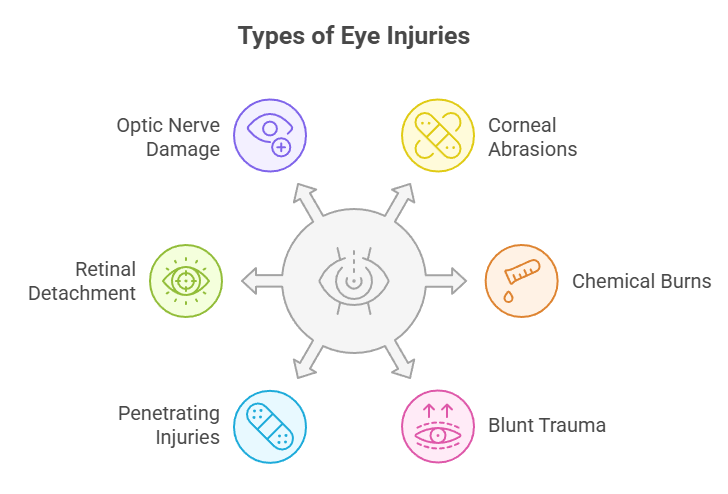Texas Eye Injury Claims: Legal Rights and Compensation
Eye injuries, whether caused by an accident, medical mistake, or another party’s negligence, can affect nearly every part of a person’s life. In Texas, victims of these injuries may have legal grounds to seek compensation for both physical and financial losses. Whether the harm involves temporary irritation, partial vision loss, or permanent blindness, the law allows individuals to hold responsible parties accountable.
Understanding when and how you can sue – and what your case might be worth – depends on the circumstances surrounding the injury. This article explains your legal rights, outlines the types of damages available, and walks through what’s required to file a successful claim under Texas law.
Types of Eye Damage: From Irritation to Blindness
Eye injuries vary widely in severity. Some are temporary and respond well to treatment, while others cause long-term complications or permanent vision loss. Understanding the different types of eye injuries – and their potential legal implications – is a critical first step if you’re considering legal action.

Common types of eye injuries include:
- Corneal abrasions: Surface scratches caused by dust, debris, or accidental contact. Though often minor, they can lead to infection or scarring if untreated.
- Chemical burns: Exposure to harsh cleaning agents, industrial chemicals, or other corrosive substances can damage the surface or interior of the eye. Immediate treatment is vital.
- Blunt trauma: A direct blow to the eye can cause internal bleeding, swelling, or even rupture. This is common in physical assaults or sports injuries.
- Penetrating injuries: Sharp objects that pierce the eye can result in permanent damage or require surgical repair.
- Retinal detachment: Often caused by trauma, this condition can lead to blindness if not treated quickly.
- Optic nerve damage: Injuries affecting the optic nerve can disrupt communication between the eye and brain, resulting in vision loss that may be irreversible.
Partial vs. complete vision loss
Many victims experience partial loss – such as blurry vision, blind spots, or difficulty seeing in low light. Others may suffer full blindness in one or both eyes. Even minor impairments can make daily tasks difficult and reduce earning potential.
These injuries often require urgent medical care, and in severe cases, long-term rehabilitation, assistive devices, or permanent lifestyle adjustments.
When Eye Injuries Lead to Legal Action
Not every eye injury results in a lawsuit. But if another person, company, or organization was careless or violated safety standards, Texas law allows injured individuals to pursue financial compensation through a civil claim.
Legal action is typically possible in situations like:
- Car accidents: Debris, shattered glass, or airbag deployment can lead to eye trauma. If another driver was at fault, you may have grounds for a personal injury case.
- Workplace incidents: Jobs involving chemicals, heavy machinery, or dangerous tools increase the risk of eye damage. Employers may be liable if proper safety equipment wasn’t provided or procedures weren’t followed.
- Medical errors: Eye surgeries or treatments gone wrong – such as LASIK complications, anesthesia mishaps, or diagnostic failures – can qualify as medical malpractice.
- Physical assault: Intentional acts like punches, kicks, or thrown objects can result in serious ocular harm. Criminal charges may be separate from your civil claim for damages.
- Defective products: Faulty goggles, malfunctioning equipment, or products lacking proper warnings can all cause preventable injuries. These cases fall under product liability law.
To successfully sue, the injured person must prove that:
- The other party had a duty to act with care.
- That duty was breached.
- The breach directly caused the eye injury.
- The injury resulted in measurable harm (such as medical bills, lost wages, or pain).
Even if the vision loss seems minor, you may still have a claim if it affected your ability to work or enjoy life as you did before.
Proving Someone Else Caused the Harm
In Texas, no matter how serious your eye injury is, you’ll need to prove that someone else caused it through careless or wrongful conduct. This is the core of any personal injury claim – and it’s often the most challenging part of the legal process.
To establish liability, your case must show four key elements:
- Duty of care: The other party had a legal obligation to act responsibly. For example, drivers must follow traffic laws, and employers must maintain a safe workplace.
- Breach of duty: They failed to meet that obligation – through action or inaction. This might include running a red light, skipping safety checks, or misdiagnosing a medical issue.
- Causation: There must be a clear link between the breach and your injury. Medical experts may be required to connect the dots between the incident and the damage to your eye.
- Damages: You must demonstrate that you suffered losses, such as medical expenses, lost income, or pain and suffering.
Evidence that can strengthen your claim
- Medical records and diagnostic scans
- Photos of the injury and the accident scene
- Witness statements or surveillance footage
- Expert testimony from eye specialists or safety professionals
- Product recalls or inspection reports (in defective product cases)
Texas follows a modified comparative fault rule. If you are found to be partly at fault, your compensation is reduced proportionally. But if you’re more than 50% responsible, you won’t be eligible to recover damages. This makes it especially important to build a solid, evidence-backed case.
What Compensation Can Cover
If you’ve suffered an eye injury due to someone else’s negligence, Texas law allows you to pursue financial compensation for the full scope of your losses – not just your medical bills. Vision damage often affects multiple parts of life, from employment and independence to emotional well-being.
Compensation may include:
- Medical expenses: Coverage for emergency treatment, surgery, follow-ups with eye specialists, medications, and assistive technology such as magnifiers or adaptive devices.
- Rehabilitation and therapy: This includes vision therapy, occupational therapy, or counseling to help adjust to vision changes or blindness.
- Lost income: If the injury forced you to miss work or reduced your ability to do your job, you may recover wages lost during recovery or compensation for future income loss.
- Loss of earning capacity: For long-term or permanent vision loss, especially in younger victims, the court may consider the projected loss of career opportunities.
- Pain and suffering: Compensation for the physical discomfort, anxiety, or emotional distress resulting from the injury.
- Loss of enjoyment of life: If hobbies, activities, or daily routines have been affected by your vision impairment, this may factor into the damages awarded.
In more severe cases – such as permanent blindness or disfigurement – settlements or jury awards may also reflect the cost of lifelong care or home modifications, like guide dog training, mobility assistance, or remodeling for accessibility.
Don’t Miss the Deadline to File
Texas law gives you a limited window to file a personal injury lawsuit after an eye injury. This legal time limit is known as the statute of limitations, and missing it could prevent you from recovering any compensation – no matter how strong your case is.
Standard time limit:
In most situations, you have two years from the date of the injury to file a claim in Texas civil court.
Key exceptions that may extend the deadline:
- Delayed discovery: If the injury wasn’t immediately apparent – such as complications from a surgical error – the clock may start when the injury is reasonably discovered.
- Injured minors: If the victim is under 18, the two-year limit typically starts on their 18th birthday, giving them until age 20 to file.
- Fraud or concealment: If the responsible party actively hid their role in the injury, a judge may allow more time to bring a case.
Waiting too long can lead to evidence being lost and witnesses becoming unavailable. Even if you’re still being treated or waiting on a final diagnosis, you should speak with a lawyer early to protect your rights and begin gathering documentation.
Why a Lawyer Can Make the Difference
Eye injury claims are more than just paperwork – they often involve complex medical evidence, expert testimony, and negotiations with insurance companies that may try to minimize your losses. Having an experienced personal injury lawyer can significantly improve your chances of receiving fair compensation.
Here’s how a lawyer can help you:
- Case evaluation: They’ll review your situation to determine if you have a strong claim and advise you on the best course of action.
- Evidence gathering: A lawyer will collect and organize medical records, witness statements, incident reports, and other supporting materials needed to build your case.
- Expert coordination: In more serious cases, attorneys work with medical experts, safety engineers, or vocational experts to validate your injuries and long-term needs.
- Dealing with insurers: Insurers often aim to settle quickly and for as little money as possible. An attorney can handle all communications and negotiations, preventing costly mistakes.
- Court representation: If a fair settlement isn’t offered, your lawyer can file a lawsuit and represent you throughout litigation.
Genthe Law Firm personal injury lawyers in Dallas offer free consultations and work on a contingency fee basis – meaning you pay nothing unless your case wins or settles. This gives injury victims access to legal help without upfront costs.
FAQs about Suing for Eye Injuries in Texas
What if my injury only caused partial vision loss?
Even if your vision isn’t completely gone, you can still sue if the impairment affects your ability to work, drive, or manage daily activities – and if another party is legally responsible.
Can I file a lawsuit if I was injured at work?
Most Texas employers carry workers’ compensation insurance, which typically prevents lawsuits. However, if your employer doesn’t provide coverage or if a third party (like a contractor or equipment manufacturer) was involved, you may have the right to sue.
Is it worth suing for a temporary eye injury?
That depends on the severity and the impact. If you missed work, had medical bills, or suffered significant pain or stress, you may still have a valid claim – especially if the injury was preventable.
How much compensation can I expect for permanent vision loss?
There’s no set amount. Compensation varies based on your age, occupation, long-term care needs, and how much the injury affects your life. Some blindness cases result in settlements or verdicts in the six- or seven-figure range.
Do I need a lawyer even if the other side admits fault?
Yes. Admitting fault doesn’t mean the insurance company will offer fair compensation. An attorney ensures your claim includes all losses and helps you avoid being pressured into a low settlement.
How long does an eye injury case usually take?
It varies. Some settle in a few months, especially if the facts are clear. Others, especially those involving permanent damage or complex medical issues, may take a year or more to resolve – particularly if they go to court.
Call for Legal Help After an Eye Injury in Texas
If you or someone you love has suffered an eye injury, partial vision loss, or blindness due to someone else’s negligence, it’s time to take the next step. The experienced attorneys at Genthe Law Firm are ready to review your case, explain your options, and fight for the compensation you deserve.
Call (214) 957-0898 today for a free consultation.
Page Contents
- Texas Eye Injury Claims: Legal Rights and Compensation
- Types of Eye Damage: From Irritation to Blindness
- When Eye Injuries Lead to Legal Action
- Proving Someone Else Caused the Harm
- What Compensation Can Cover
- Don’t Miss the Deadline to File
- Why a Lawyer Can Make the Difference
- FAQs about Suing for Eye Injuries in Texas
- Call for Legal Help After an Eye Injury in Texas



